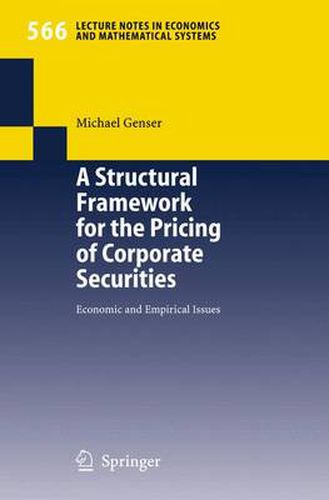A Structural Framework for the Pricing of Corporate Securities: Economic and Empirical Issues
Michael Genser

A Structural Framework for the Pricing of Corporate Securities: Economic and Empirical Issues
Michael Genser
This title is printed to order. This book may have been self-published. If so, we cannot guarantee the quality of the content. In the main most books will have gone through the editing process however some may not. We therefore suggest that you be aware of this before ordering this book. If in doubt check either the author or publisher’s details as we are unable to accept any returns unless they are faulty. Please contact us if you have any questions.
In the last few years, a re?ned pricing of corporate securities has come intofocusofacademicsandpractitioners.Asempiricalresearchshowed, traditionalassetpricingmodelscouldnotpricecorporatesecuritiess- ?ciently well. Time series properties of quoted securities were di?cult to replicate. In the search for more advanced models that capture the empirical ?ndings, researchers followed two approaches. The ?rst stream of - search ?tted the time series properties of corporate securities directly. Werefertothisclassofmodelsasbeingofreducedform.Securityprices are assumed to follow more advanced stochastic models, in particular 1 models withe.g. non-constant volatility. All studiesofthistypedonot consider the economics of the issuing companies but simply assume a stochastic behavior of the security or its state variables. In contrast, a second, economic literature developed by studying the ?rm. We call these kinds of models structural because the limited liability of equity holders is modeled explicitly as a function of ?rm value. One problem of the reduced form approach is its di?culty of int- pretation in an economic sense. Being technically advanced, reduced form models often lack an intuitive economic model and especially d- guise the economic assumptions. If security pricing is the only purpose of the exercise, we might not need an economic model. However, if we wanttounderstandpricemovements,aseriouslinkwiththeunderlying economics appears important. Thecreditriskliteratureevenadoptedthisparticularterminologyto 2 categorize its models. Whereas reduced form models take each corpo- 1 See e.g. Stein and Stein (1991) for a stochastic volatility model and Heston and Nandi (2000) on GARCH option pricing.
This item is not currently in-stock. It can be ordered online and is expected to ship in 7-14 days
Our stock data is updated periodically, and availability may change throughout the day for in-demand items. Please call the relevant shop for the most current stock information. Prices are subject to change without notice.
Sign in or become a Readings Member to add this title to a wishlist.


